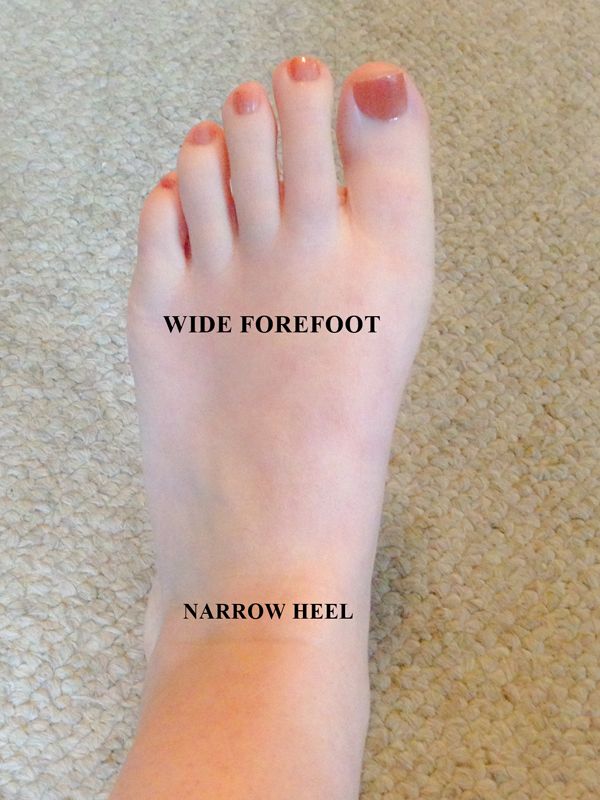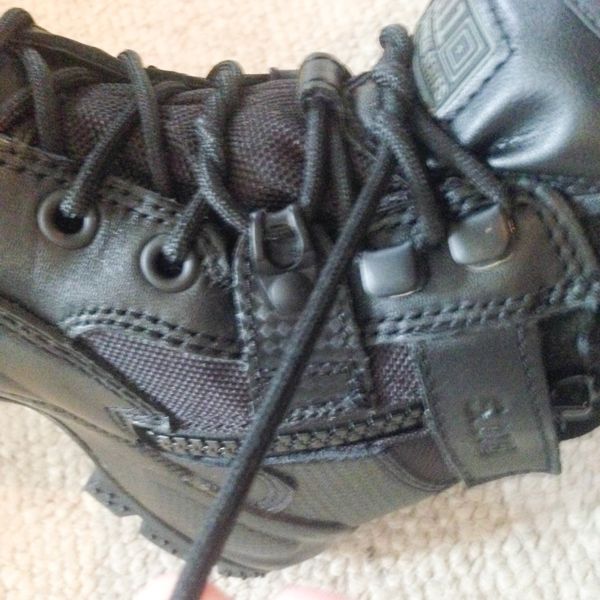By Caitlyn Armistead, C1 Contributor
It’s 2015, and one would think a woman could walk into any uniform store and buy a pair of women’s duty boots. Yet often, due to lack of options in women’s lines, lack of stock, or budgetary dictations, women must make due with boots designed for men.
Women’s and men’s calves, ankles, and feet have differing proportions: both medial and lateral longitudinal arches are different and the big toe and ball of the foot transfer force in different ways. When a woman must wear a men’s boot, there are usually some adjustments that need to be made.
Arch support
After shoe length (shoe size), medial arch fit is one of the most obvious fit issues, and it is not gender specific. Proper arch support prevents foot pronation and supination. Because arch support affects the balance and angle of the foot and ankle, it is important to fix that area of the boot prior to evaluating and adjusting the remaining fit.
Most factory inserts have low arches, as highly-arched feet are less common than low or flat feet. The only way to adjust arch support is to replace the factory insert with one more appropriate to the wearer’s foot. Inserts range in cost from $20 for a Dr. Scholls off-the-shelf model to $200 for a hard plastic custom-made insert. Factory inserts are easy to remove; usually they are not glued in. Find an insert that fits your arch. If necessary, trim padding and slide the insert into place.
Toe box

A woman’s foot is wide in the forefoot and narrow in the heel.
A woman’s foot, when compared to a man’s, is wide in the forefoot and narrow in the heel. When a mens boot fits well across the forefoot, often there will be too much room in the toe space or the heel. Toe space isn’t usually a deal breaker, but one must be careful to monitor the force transference, particularly in running shoes).
At times, extra space in the toe box can lead to problems, especially when hiking or walking downhill. Unfortunately, toe box space cannot be adjusted—choose accordingly.
Bar lacing for high volume feet.
Optimize volume fit with boot lacing
Volume = length x width x height.
When fitting shoes, we commonly think of shoe length and perhaps width, but rarely the height of the space inside the boot or shoe. However, the volume of the foot, whether high or low, impacts boot fit. Luckily, volume can be significantly altered with boot lacing techniques. High volume feet, those with a tall foot height and, usually, high arches benefit from bar or ladder lacing, which allows maximum facing spread. Generally speaking, most women have low volume feet which benefit from diagonal cross lacing (normal lacing) and lacing outside of the tongue loop.
Diagonal lacing with no tongue loop for low volume feet
The tongue loop is designed to keep the tongue from slipping off to one side or the other during use. It also keeps the laces straight and pretty on a normal to wide/high volume foot. Sometimes, though, the tongue loop can prevent the facing from fully tightening. By lacing outside the loop (ignoring it), increased tension can be attained.
Securing the laces
Surgeon’s knot.
Different areas of the shoe may need differing amounts of tension to maintain fit. It is often helpful to secure lower lacing with a surgeon’s knot, an overhand knot that is wound around three times. When dressed flat, a surgeon’s knot uses friction to maintain itself without having another knot behind it. You can let go, and it will maintain itself.
Lace the boot from forefoot to the base of the ankle and secure with a surgeon’s knot. Ankle tension can then be manipulated without losing forefoot adjustments.
Heel fit
Remember, women’s heels are usually narrower and smaller than men’s, so even when a men’s boot ‘fits,’ there will often be a lot of heel movement. Movement creates friction; friction creates blisters. Significant horizontal heel movement cannot be adjusted — a different boot must be chosen.
Vertical movement can often be fixed with a heel lock. A heel lock creates tension with a pulley action. To tie, ladder lace the top notches of the boot and then cross and tuck the laces under the opposite lace and tie. Consider using another surgeon’s knot in order to maintain the pressure.
Heel Lock, Step 1: Ladder Lacing
-1.jpg)
Heel Lock, Step 2: Tuck under the ladder lacing

Heel Lock, Step 3: Surgeon’s knot
Calf fit
I’m not saying women have fat legs. However, women have longer calf muscles than men, so even though we may have proportionally smaller muscle mass, the muscle and its tendons extend further down into the boot, especially if you’re short in stature. This calf size difference can create uncomfortable pressure on the back of the boot collar. Compound discomfort with any slight bit of knee hyperextension and sizeable force can be placed on the calf.
A 6” boot may only be 5 ¼” in the heel.
The only way to fix this is to enlarge the boot in the calf area by breaking it in or stretching it. Stretching, through heat or freezing, should be a last-resort technique because the changes, good or bad, are permanent and may violate warranties or guarantees. If you have problems in this area and choose not to stretch your boots, choose a boot that rides low on the boot collar or has an Achilles notch. For example, 5.11’s 6" mens boot is 6" in the front, but only 5.25" in the back.
Breaking in boots
Breaking in boots is simple. Wear them as much as you can, especially around the house where you can take them off if they become painful. Be careful when breaking in boots. Any slight discomfort should resolve quickly. If it does not or the boots become painful, stop wearing them. Tendonitis can require complete rest in order to heal, and no one wants to lose work time over a pair of boots.
Pressure across the tibia at the front of the boot collar can be adjusted with the same lacing techniques used on the forefoot: ladder lacing for extra width and give, cross lacing for those with narrow legs. Again, using a surgeon’s knot can be useful for maintaining tension.
Socks
While boot fit is paramount in blister prevention, the importance of socks cannot be overemphasized. Socks should be well fitting to avoid wrinkles and hot spots and should extend slightly above the boot cuff. They should be made of an appropriate material. Cotton socks are poor insulators and soak up moisture which puts you on the quick road to blisters. Wool socks, particularly Merino wool, are ideal for warmth in the winter and for wicking away sweat in the summer. Keep an extra pair of socks handy while on duty because no matter the material, if your socks become wet or dirty, you should change them out as soon as possible.
Trends in boot design
If it seems there are fewer options in womens boots these days, you are not far from the truth. In my product research and discussion with a pedorthist – which is a professional trained in sizing, fitting, and modifying footwear – many boot makers are limiting women’s lines and changing their boots’ proportions to attempt a more unisex fit and even marketing ‘unisex’ boots. Or they ignore women’s lines altogether and simply make the mens boots in smaller sizes.
Cyclical variations in fit
So you buy your boots and they fit well, but one morning you wake up, and they don’t fit any more. What gives? Hormones.
Ligaments contain estrogen receptors, and as estrogen levels rise in the mid part of the menstrual cycle they cause changes in the tissue, even to the point of increasing the chance of injury. Some women have more trouble at the end of their cycle when progesterone causes water retention and relaxin causes foot structures to spread. These problems can at times be fixed with thick socks (to fill leftover volume), relacing (to decrease shoe volume), or by wearing inserts worn only during certain times of the cycle. At a minimum, be aware of the effect your cycle has on your feet and cautious to prevent injury.
Finding help with boot fit
Though options have changed in recent years, there are still many types, styles, and lines to choose from. If you are looking for your first set of boots or your feet have changed shape (for example, due to pregnancy), find a store that has a certified pedorthist who can help you find the right boot.
About the Author
Caitlyn Armistead is a teacher and author in the deep south. She entered EMS in 1994 and has served as a National Registry First Responder, Lifeguard, National Registry EMT-Intermediate, and EMS research librarian. As an outreach to those who are seeking help and healing, she writes novels that address some of the difficult issues facing public safety, such as drug abuse, disabilities, PTSD, rape, and domestic violence. Caitlyn’s blog can be found at: http://www.caitlynarmistead.blogspot.com and she can be contacted at: caitlynarmistead@gmail.com






